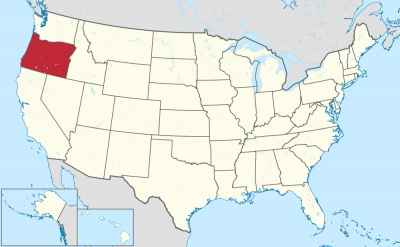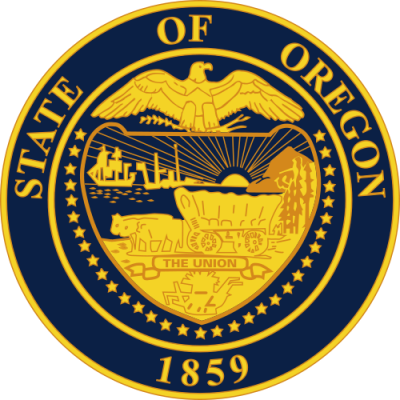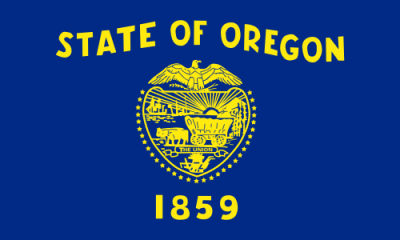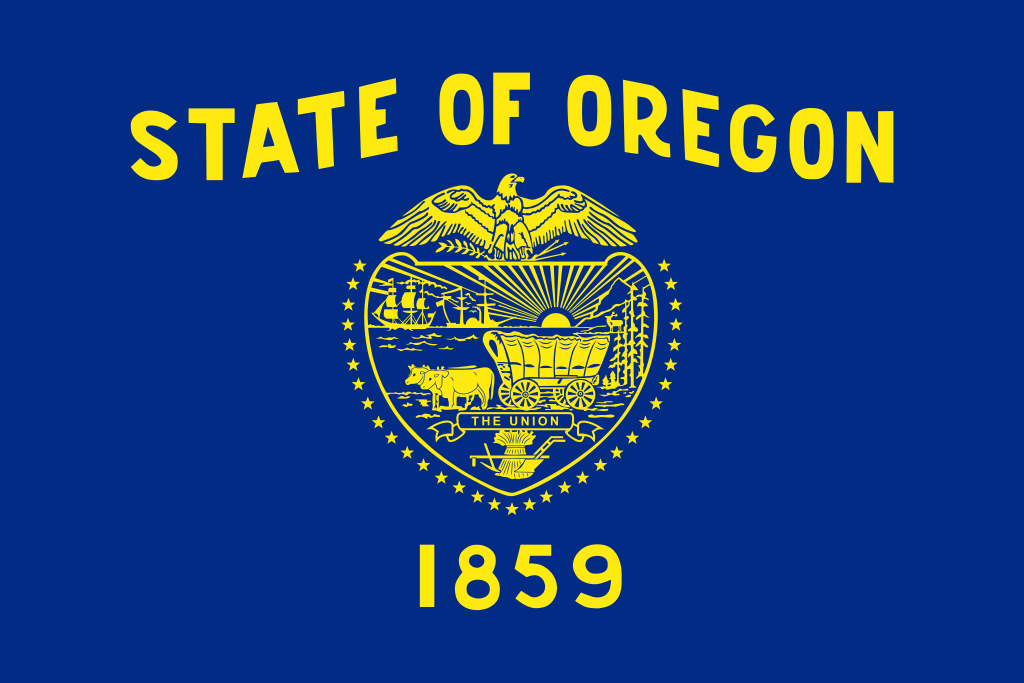


Oregon (engl. Aussprache [ˈɔrɪɡən]) ist ein Bundesstaat der Vereinigten Staaten von Amerika. Er liegt im Westen der Vereinigten Staaten in der Region Pazifischer Nordwesten und wurde im Jahr 1859 als 33. Bundesstaat aufgenommen.
Flächenmäßig ist Oregon der neuntgrößte Bundesstaat, mit einer Bevölkerung von knapp über 3,8 Millionen (2010) liegt er unter den Bundesstaaten hingegen nur an 27. Stelle. Ein Großteil der Bevölkerung konzentriert sich im Willamette Valley im Nordwesten des Staates. Dort liegen mit Portland, Eugene und der Hauptstadt Salem auch die drei größten Städte Oregons.
オレゴン州(英: State of Oregon)は、北米西海岸に位置する、アメリカ合衆国33番目の州である。太平洋に沿って北にワシントン州、南にカリフォルニア州と接し、内陸の南東はネバダ州、東はアイダホ州である。北はコロンビア川、東はスネーク川が州境の大半を形作っている。1843年にオレゴン・カントリーの自治的な政府を樹立した交易業者、探検家および開拓者が訪れるまでは、アメリカ・インディアンの多くの部族が住んでいた。1848年にオレゴン準州が設立され、1859年2月14日にアメリカ合衆国33番目の州に昇格した。
ワシントン州、カリフォルニア州と共にリベラルな気風で、保守的な中西部に対して「レッドウッド・カーテンの向こう側」と称される。
現代の先進国では珍しい直接民主制によって作られ、州、郡からも独立した地域政府メトロを擁する。
セイラムが州都であり、人口では州内第3位である。人口最多の都市はポートランドである。2010年国勢調査による州人口は380万人以上であり、2000年から12%増加した[1]。ポートランドの人口は同年で583,776人であり、全米第29位である。その都市圏人口は2,241,841人(2009年推計)で全米第23位である。州西部、ウィラメット川のあるバレーに人口が集中しており、州内の人口上位10都市のうち8都市がこのバレーに入っている。
州内には多様な景観がある。風に吹き曝される太平洋岸、カスケード山脈のゴツゴツして氷河に侵食された火山、マルトノマ滝など多くの滝、深い常緑樹の森、また州東部の大半でグレートベースンまで拡がる高原型砂漠などである。雨の多い州西部海岸にある背の高いダグラスファーやセコイアの木は、州東半分を覆う火を着けやすい松やジュニパー(セイヨウネズ)の疎らに生えた林と対照的である。州中央から東には半乾燥の灌木地、プレーリー、砂漠、ステップおよび牧草地が拡がっている。標高11,249フィート (3,429 m) のフッド山が州内最高地点である。クレーターレイク国立公園が州内唯一の国立公園である。
Oregon (/ˈɒr(ɪ)ɡən/ (![]() listen) ORR-(ih)-gən)[7] is a state in the Pacific Northwest region on the West Coast of the United States. The Columbia River delineates much of Oregon's northern boundary with Washington, while the Snake River delineates much of its eastern boundary with Idaho. The 42° north parallel delineates the southern boundary with California and Nevada.
listen) ORR-(ih)-gən)[7] is a state in the Pacific Northwest region on the West Coast of the United States. The Columbia River delineates much of Oregon's northern boundary with Washington, while the Snake River delineates much of its eastern boundary with Idaho. The 42° north parallel delineates the southern boundary with California and Nevada.
Oregon has been home to many Indigenous nations for thousands of years. The first European traders, explorers, and settlers began exploring what is now Oregon's Pacific coast in the early-mid 1500s. As early as 1565, the Spanish began sending vessels northeast from the Philippines, riding the Kuroshio Current in a sweeping circular route across the northern part of the Pacific. In 1592, Juan de Fuca undertook detailed mapping and studies of ocean currents in the Pacific Northwest, including the Oregon coast as well as the strait now bearing his name. Spanish ships – 250 in as many years – would typically not land before reaching Cape Mendocino in California, but some landed or wrecked in what is now Oregon. Nehalem tales recount strangers and the discovery of items like chunks of beeswax and a lidded silver vase, likely connected to the 1707 wreck of the San Francisco Xavier.[8]
In 1843, an autonomous government was formed in the Oregon Country, and the Oregon Territory was created in 1848. Oregon became the 33rd state of the U.S. on February 14, 1859. Today, with 4 million people over 98,000 square miles (250,000 km2), Oregon is the ninth largest and 27th most populous U.S. state. The capital, Salem, is the second-most populous city in Oregon, with 169,798 residents. Portland, with 647,805, ranks as the 26th among U.S. cities. The Portland metropolitan area, which also includes the city of Vancouver, Washington, to the north, ranks the 25th largest metro area in the nation, with a population of 2,453,168.
Oregon is one of the most geographically diverse states in the U.S.,[9] marked by volcanoes, abundant bodies of water, dense evergreen and mixed forests, as well as high deserts and semi-arid shrublands. At 11,249 feet (3,429 m), Mount Hood, a stratovolcano, is the state's highest point. Oregon's only national park, Crater Lake National Park, comprises the caldera surrounding Crater Lake, the deepest lake in the United States. The state is also home to the single largest organism in the world, Armillaria ostoyae, a fungus that runs beneath 2,200 acres (8.9 km2) of the Malheur National Forest.[10]
Because of its diverse landscapes and waterways, Oregon's economy is largely powered by various forms of agriculture, fishing, and hydroelectric power. Oregon is also the top timber producer of the contiguous United States, and the timber industry dominated the state's economy in the 20th century.[11] Technology is another one of Oregon's major economic forces, beginning in the 1970s with the establishment of the Silicon Forest and the expansion of Tektronix and Intel. Sportswear company Nike, Inc., headquartered in Beaverton, is the state's largest public corporation with an annual revenue of $30.6 billion.[12]
L’Oregon /ɔ.ʁe.ɡɔ̃/2 (en anglais : /ˈɔɹɨɡən/3 Écouter) est un État du Nord-Ouest des États-Unis, situé sur la côte Pacifique entre les États de Washington au nord, de Californie au sud, du Nevada au sud-est, et de l'Idaho à l'est. Ses frontières au nord et à l'est suivent pour l'essentiel les cours du fleuve Columbia et de la rivière Snake. Le territoire est intégralement traversé par la chaîne des Cascades qui forme une importante barrière climatique : l'ouest de l'État, de climat océanique, est recouvert par la forêt tempérée humide tandis que sa partie est, semi-aride, est occupée par le Haut désert de l'Oregon. Le parc national de Crater Lake se trouve dans le sud de l'État. La réserve indienne de Warm Springs s'étend sur 2 640,2 km2 dans le nord de l'État, sur le versant Est de la chaîne des Cascades.
L'actuel territoire de l'Oregon était occupé par les peuples amérindiens Bannocks, Chinook, Klamaths et Nez-Percé, il est atteint par l'expédition Lewis et Clark en 1805. À partir des années 1830, la piste de l'Oregon est empruntée par les pionniers dont le nombre supplante rapidement celui des autochtones. Le traité de l'Oregon, signé le 15 juin 1846, fixe la frontière américano-canadienne et aboutit à la création du territoire de l'Oregon dont la partie sud-ouest qui forme l'Oregon actuel est admise le 14 février 1859 comme 33e État de l'Union.
Entre 1902 et 1908, les efforts de la Direct Legislation League font de l'Oregon un précurseur en matière de démocratie directe (référendum, initiative populaire, révocation populaire des élus4,5) par l'instauration de l'Oregon System6,4 qui s'étendra par la suite à d'autres États. L'Oregon est un État traditionnellement démocrate7. Il est surnommé « L’État du castor » et ses habitants sont appelés Orégonais et Orégonaises.
L'Oregon a pour capitale Salem tandis que la ville la plus peuplée est Portland. Cette dernière s'étend au nord de la vallée de la Willamette qui regroupe 70 % de la population orégonaise8. L'ouest de Portland est occupé par le technopole de Silicon Forest qui accueille les principaux centres de recherche d'Intel, l'Oregon est également le berceau de Nike et de Columbia Sportswear Company.
L'Oregon (AFI: /ˈɔreɡon/[2]; in inglese: /ˈɔɹɪgən/) è uno Stato federato degli Stati Uniti d'America situato nella regione del Pacifico nord-occidentale. Confina ad ovest con l'Oceano Pacifico, a nord con lo stato di Washington, a sud con la California, ad est con l'Idaho e a sud-est con il Nevada. Il fiume Columbia delinea gran parte del confine settentrionale dello stato, e il fiume Snake costituisce gran parte del confine orientale. Il 42º parallelo nord segna invece il confine meridionale con California e Nevada. L'Oregon è uno dei tre stati degli Stati Uniti d'America continentali ad avere una costa sull'Oceano Pacifico, e la prossimità con l'oceano influenza significativamente il clima invernale mite dello stato, nonostante la latitudine.
L'Oregon fu abitato da molte tribù indigene prima dell'arrivo dell'insediamento dei commercianti ed esploratori occidentali. Nel 1843 si costituì un governo autonomo nell'Oregon Country, e il Territorio dell'Oregon fu creato nel 1848; l'Oregon divenne il 33º stato degli USA il 14 febbraio 1859. Attualmente, con i suoi 255.000 km², lo stato è il nono stato per superficie e, con una popolazione di 4 milioni di abitanti, è il 27º stato più popolato degli USA. La capitale è Salem, che è la seconda città più popolata dello stato, con 173.442 residenti (dato del 2018). Portland è invece la città più popolata, con 653.115 abitanti (dato del 2018), che si posiziona 26ª nella lista delle città più popolate degli Stati Uniti. L'area metropolitana di Portland conta 2.389.228 abitanti, e si posiziona 23ª tra le maggiori aree metropolitane della nazione; la Willamette Valley, nell'Oregon occidentale, rappresenta la parte dello stato più densamente popolata, dove vi sono otto delle dieci città più popolose.
Il panorama dell'Oregon è diversificato, con una costa ventosa, una Catena delle Cascate costellata di vulcani, una moltitudine di laghi sulle cascate e ad ovest, foreste pluviali temperate, temperate e decidue alle più basse altitudini, e un High Desert che si estende per gran parte dell'area orientale dello stato, fino al Gran Bacino. Le alte conifere, principalmente abeti di Douglas che si trovano sulla costa occidentale molto piovosa, contrastano con i più leggeri pini che ricoprono le porzioni orientali dell'Oregon. Gli abbondanti ontani nell'ovest fissano l'azoto per le conifere. Spostandosi verso est dell'Oregon centrale vi sono sterpaglie, praterie, deserti, steppe e prati. Con i suoi 3.429 metri di altitudine, il Monte Hood è il punto più alto dello stato. Lo Stato è coperto per circa il 60% della sua estensione da foreste e ospita diversi parchi nazionali. Il Parco nazionale del lago Crater, comprende la caldera che circonda il Lago Crater, il più profondo degli Stati Uniti. Il soprannome dello Stato è Beaver State, ossia "lo Stato dei castori", animali molto diffusi nella regione.
Oregón2 (en inglés, Oregon) es uno de los cincuenta estados que, junto con Washington D. C., forman los Estados Unidos de América. Su capital es Salem y su ciudad más poblada, Portland. Se ubica en la región Oeste del país, división Pacífico y limita al norte con el estado de Washington, al este con Idaho —gran parte de esta frontera la forma el río Snake—, al sureste con Nevada, al sur y suroeste con California y al oeste con el océano Pacífico. Con 254 805 km² es el noveno estado más extenso, por detrás de Alaska, Texas, California, Montana, Nuevo México, Arizona, Nevada y Colorado. Fue admitido en la Unión el 14 de febrero de 1859, como el estado número 33.
Los ríos Columbia y Snake forman la mayor parte de sus fronteras al norte y este, respectivamente. El valle del río Willamette en el oeste de Oregón es la región más densamente poblada y en la que la agricultura es más productiva. La zona fue habitada por muchas tribus indígenas antes de la llegada de los comerciantes, exploradores y colonos que formaron el gobierno autónomo de Oregon Country en 1843. El territorio de Oregón fue creado en 1848 y se convirtió en el estado de Oregón el 14 de febrero de 1859.
Oregón tiene uno de los paisajes más diversos que incluye la ventosa costa del Pacífico, con volcanes, glaciares y montañas escarpadas de la cordillera de las Cascadas. Se conoce por sus bosques altos y densos que cubren un tercio del norte del estado y la mitad del sur. Otras áreas incluyen llanuras y desiertos que cubren aproximadamente la mitad del estado en el este y el norte central, y bosques menos densos de pinos en el noreste.
Monte Hood (3.429 m) es el punto más alto del estado. El parque nacional Crater Lake es el único parque nacional en Oregón.
Орегон[1] (англ. Oregon [ˈɔrɪɡən]) (варианты ударения: О́регон[2] и Орего́н[3]) — штат[4] на северо-западе США, один из так называемых Тихоокеанских штатов. Население — 4 142 776 человека (27-е место среди штатов; данные 2017 года). Столица — Сейлем, крупнейший город — Портленд. Другие крупные города — Юджин, Грешем, Бивертон, Медфорд, Корваллис, Спрингфилд, Астория.
Официальный девиз штата — «Летит на собственных крыльях» (лат. Alis Volat Propriis). Официальное прозвище — «Бобровый штат» или «Штат бобра» (англ. Beaver State). Орегон — единственный штат США, имеющий двухсторонний флаг[5]. На одной стороне изображена печать штата, а на оборотной стороне — бобр.




 Geography
Geography



